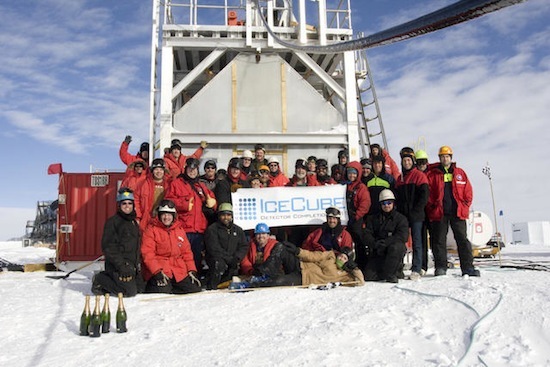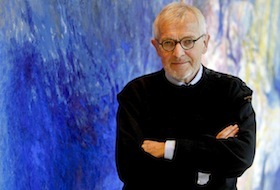IceCube named 2013 Breakthrough of the Year for neutrino discovery

After six years of deployment, the IceCube Neutrino Observatory in Antarctica was completed in December 2010. After reporting the first evidence of cosmic neutrinos in 2013, it was named the Physics World Breakthrough of the Year.
Less than one month after reporting the first evidence for cosmic neutrinos, the IceCube project received the 2013 Breakthrough of the Year award from the British magazine Physics World.
“The ability to detect cosmic neutrinos is a remarkable achievement that gives astronomers a completely new way of studying the cosmos,” says Hamish Johnston, editor of Physicsworld.com. “The judges were also impressed with the IceCube Collaboration’s ability to build and operate a huge and extremely sensitive detector in the most remote and inhospitable place on Earth.”
The IceCube Neutrino Observatory was completed in Antarctica in December 2010, after seven years of construction.

Francis Halzen
“I did not imagine that the science would be as exciting as building this detector,” says Francis Halzen, principal investigator of IceCube and the Hilldale and Gregory Breit Professor of Physics at the University of Wisconsin–Madison. “The challenges were many, from deciphering the optical properties of ice that we have never seen to drilling 86, 2.5-kilometer holes in two days apiece.”
The ice is the perfect medium to detect high-energy neutrinos born in ultra-high energy phenomena in deep space. After they travel the universe for millions, even billions, of years, a tiny percentage of these neutrinos can be detected by some of the 5,160 optical sensors after they interact with atomic nuclei in the ice.
The observatory’s construction and operation have been funded by the U.S. National Science Foundation and partner agencies around the world. UW–Madison is the lead institution of the IceCube Collaboration, which has 275 physicists and engineers from the U.S., Germany, Sweden, Belgium, Switzerland, Japan, Canada, New Zealand, Australia, the U.K., Korea and Denmark.
Watch a Physics World Google Hangout from Friday, Dec. 13 on the Physics World Google+ page and the Physics World YouTube channel.
Participants include:
- In London, Hamish Johnston, editor of physicsworld.com;
- In Madison, Professor Francis Halzen, principal investigator of IceCube;
- At the Amundsen-Scott South Pole Station, James Roth, a member of the IceCube Collaboration and a senior electronics instrument specialist at University of Delaware.




